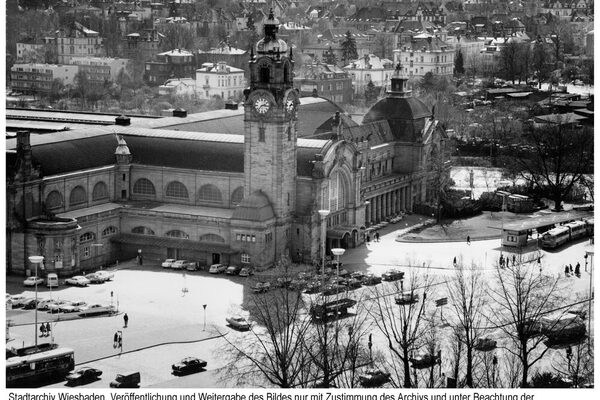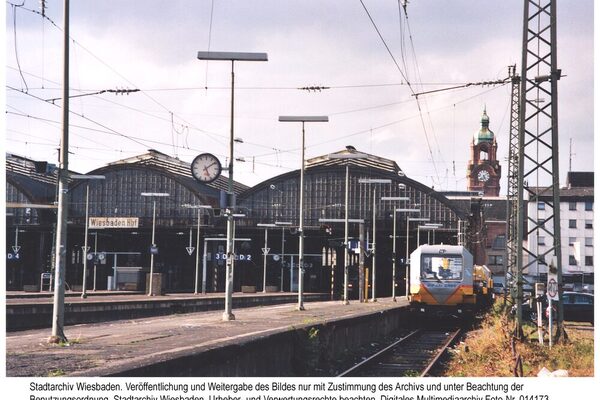Central station
Until the completion of Wiesbaden Central Station in 1906, the city had three railroad stations: Taunusbahnhof, Rheinbahnhof and Ludwigsbahnhof. The new station was intended to replace these and bring the different railroad lines together.
As part of the redesign of the railroad facilities in Wiesbaden at the turn of the century(railroad stations), the decision was made to build a central station with the configuration of a terminus station as in Frankfurt am Main, Leipzig, Stuttgart or Munich. The reception building of the main station, which opened on November 15, 1906, is committed to the formal language, the love of splendour and the preference for asymmetrical layouts of late historicism. Even contemporaries were puzzled by the mixing of styles typical of this era; the Wiesbadener Tagblatt newspaper wrote at the time of a "skillful confusion of Baroque, Renaissance and Art Nouveau".
The architect was Fritz Klingholz (1861-1921), who was one of the most important railroad station architects in Germany. Wilhelm II played a major role in the architectural design: The design of the roof with green and natural red tiles and, above all, the height of the clock tower of 40 m at the main entrance can be traced back to the emperor; Klingholz had originally wanted to make the tower higher. Such interventions by the monarch in public buildings were quite common. The railroad stations in Hamburg (1906), Bad Homburg (1907) and Metz (1908) are in a row with Wiesbaden.
During the Second World War, the main station was partially destroyed; the Fürstenpavillon on track 1, which had only been completed in 1907, was lost. The high expectations that arose with the opening of the main station with regard to long-distance passenger traffic, which had largely bypassed Wiesbaden until then, were only partially fulfilled. After 1945, long-distance traffic was gradually shifted to the left bank of the Rhine, and in this area the importance of the through station in Mainz, which was cramped in terms of capacity but fundamentally more favorable in operational terms, steadily increased at the expense of Wiesbaden. As a result, Wiesbaden's main station, which is currently frequented by around 36,000 passengers every working day, now appears oversized. After an initial modernization in the 1970s, the station building was extensively and extensively renovated in 2003/2004. This was followed in 2009 - 2013 by the fundamental renovation of the dilapidated platform hall and the sandstone façades on the sides of the hall. Over the course of around ten years, more than 60 million euros were invested in refurbishment measures. The main station is one of the most magnificent architectural legacies of historicism in Wiesbaden.
The interior of the station building was no less magnificent than the exterior. The transverse platform hall, which protrudes from both ends of the entire structure, is huge. In striking contrast to the opulent design of the reception building is the simple, completely unadorned five-bay platform hall with 11 platforms. As a purely functional part, it is not visible at any point from the front of the station: the illusion of a palace or castle was obviously not to be disturbed by any reminiscence of the modern industrial age. In this respect, despite isolated echoes of Art Nouveau, the station reflects a fundamentally conservative architectural concept, which was not least due to the direct influence of the emperor and the monarch's corresponding architectural views. In the context of railroad station construction in the Wilhelmine Empire, however, it can be regarded as a successful representative of late historicism. New architectural approaches emerged before and during the First World War with the early modernist station buildings in Darmstadt (1912), Karlsruhe (1913) and Leipzig (1915).
Literature
"A magnificent building, and a modern one". 100 years of Wiesbaden Central Station. In: Yearbook of Railway History, Volume 38, Hövelhof 2006 (pp. 5-24).

